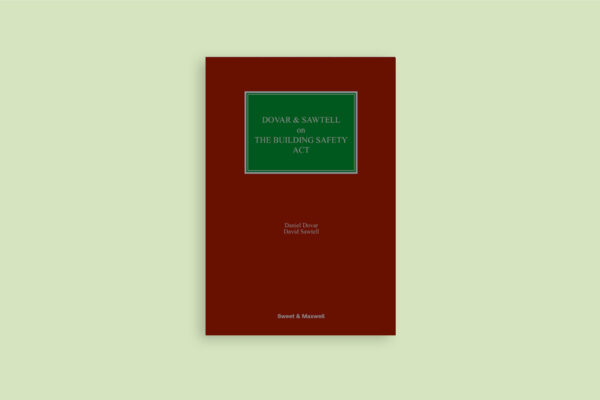Buy tickets now
Vista Tower – £13m Remediation Contribution Order made against 76 Entities

Grey GR Limited Partnerhsip v Edgewater (Stevenage) Limited and others (CAM/26UH/HYI/2023/0003) known as the Vista Tower decision, marks a significant development in the application of the ‘just and equitable’ test for Remediation Contribution Orders (RCOs), particularly in light of the upcoming appeal in Triathlon Homes LLP v Stratford Village Development Partnership & Others (2024) on 19 March 2025.
Background
Vista Tower, a 16 story, 49.5 metres high building constructed in the early 1960s and containing 73 two-bedroom residential units, was originally sold by its developer, Edgewater (Stevenage) Limited (‘Edgewater’) to Grey GR Limited Partnership (‘Grey’) as an investment opportunity.
This case originated from the discovery that Vista Tower’s external walls were built with combustible materials. Since 2020, Grey had been working with experts and obtaining proposals for a remediation plan based on the Building (Amendment) Regulations 2018 and the accompanying Consolidated Advice Note (‘CAN’). However, this standard was later withdrawn by the government. In 2022, Grey adopted a new approach based on the building safety standard PAS9980:2022 (‘PAS9980’), hoping to narrow the scope of the work and qualify for Building Safety Fund (‘BSF’) funding. The PAS9980 report recommended the removal of the combustible materials, along with necessary internal preventative and remedial actions.
Grey submitted numerous BSF applications and was the Respondent in a highly publicised parallel proceedings initiated by the government against Grey for remediation orders (‘RO Proceedings’). Works commenced in January 2024 and were projected to conclude in September 2025. Grey was subsequently confronted with a £13 million shortfall to cover the remedial works.
Procedural History
The Respondents
On 2 April 2023, Grey applied to the Tribunal for an RCO against 17 Respondents (R1-R17), seeking to claim against Edgewater and its ‘wider corporate structure’ including R2-R17, many of whom shared the Edgewater name.
Grey argued that Edgewater, as the previous landlord, commissioned the works to convert the building from office to residential use in 2015/2016 and acted as a developer for the building. Mr Frankel and Mr Dreyfuss served as directors of both Edgewater and R2-R15 at various times, and R16 held at least 75% of the shares in Edgewater.
Separately, Grey issued proceedings in the Technology and Construction Court TCC against Edgewater, R16 and R17 seeking a building liability order under s.130 of the Building Safety Act 2022 (‘the Act’). The Tribunal pointed out thatthe relevant test for association with Edgewater for these purposes was more stringent than the test for an RCO under Section 124. The latter being designed to be used in the context of protecting leaseholders from the costs of remedial works to certain buildings, whereas the former can apply to any building of any height in respect of liability arising from the Defective Premises Act 1972, Building Act 1984, and a building safety risk pursuant to the Act.
Defects and Building Safety Risks
The Law
The relevant provisions of the Act are as follows:
Section 120 of the Act
(2) A “Relevant defect”, in relation to a building, means a defect as regards the building that
(a)arises as a result of anything done (or not done), or anything used (or not used), in connection with relevant works, and
(b)causes a building safety risk.
(3) In subsection (2) “relevant works” means any of the following
(a)works relating to the construction or conversion of the building, if the construction or conversion was completed in the relevant period;
(b)works undertaken or commissioned by or on behalf of a relevant landlord or management company, if the works were completed in the relevant period;
(c)works undertaken after the end of the relevant period to remedy a relevant defect (including a defect that is a relevant defect by virtue of this paragraph).
“The relevant period” here means the period of 30 years ending with the time this section comes into force.
(4) In subsection (2) the reference to anything done (or not done) in connection with relevant works includes anything done (or not done) in the provision of professional services in connection with such works.
(4A) “Relevant steps”, in relation to a relevant defect, means steps which have as their purpose-
(a)preventing or reducing the likelihood of a fire or collapse of the building (or any part of it) occurring as a result of the relevant defect,
(b)reducing the severity of any such incident, or
(c)preventing or reducing harm to people in or about the building that could result from such an incident
(5) For the purposes of this section, “building safety risk”, in relation to a building, means a risk to the safety of people in or about the building arising from—
(a) the spread of fire, or
(b)the collapse of the building or any part of it;
“conversion” means the conversion of the building for use (wholly or partly) for residential purposes;
“relevant landlord or management company” means a landlord under a lease of the building or any part of it or any person who is party to such a lease otherwise than as landlord or tenant.
Defects (paragraphs 67-70)
Experts in the case and numerous Respondents interpreted ‘defect’ as building works that did not comply with the relevant building legislation at the relevant time. However, the Tribunal reasoned that if ‘defect’ solely meant non-compliance with building regulations, the Act would explicitly state this. Furthermore, it would be surprising if the Act restricted the term ‘defect’ to non-compliance with pre-Grenfell versions of various building regulations, which the independent Hackitt reviews had deemed inadequate. Non-compliance with building regulations is merely one way, not the only way, in which something can be considered a defect for RCO purposes.
Building Safety ‘Risk’ (paragraphs 71-76)
It was contended that PAS9980 risks categorized as ‘medium’ are tolerable risks under Section 120(5) of the Act. However, the Tribunal disagreed, stating that any risk above ‘low risk’ can constitute a building safety risk. Section 120(5) of the Act describes a risk to the safety of individuals arising from the spread of fire or collapse, not a risk reaching a tolerable or any other specific threshold. The Tribunal confirmed that the risk only needs to be a risk to the safety of people resulting from the spread of fire in a tall residential building.
Remediation Contribution Orders
The Law
The relevant provisions of the Act are as follows:
Section 124 of the Act
(1) The First-tier Tribunal may, on the application of an interested person, make a remediation contribution order in relation to a relevant building if it considers it just and equitable to do so.
(2) “Remediation contribution order”, in relation to a relevant building, means an order requiring a specified body corporate or partnership to make payments to a specified person, for the purpose of meeting costs incurred or to be incurred in remedying [F1, or otherwise in connection with,] relevant defects (or specified relevant defects) relating to the relevant building.
(2A) The following descriptions of costs, among others, fall within subsection (2)—
(a)costs incurred or to be incurred in taking relevant steps in relation to a relevant defect in the relevant building;
(b)costs incurred or to be incurred in obtaining an expert report relating to the relevant building;
(c)temporary accommodation costs incurred or to be incurred in connection with a decant from the relevant building (or from part of it) that took place or is to take place—
(i)to avoid an imminent threat to life or of personal injury arising from a relevant defect in the building,
(ii)(in the case of a decant from a dwelling) because works relating to the building created or are expected to create circumstances in which those occupying the dwelling cannot reasonably be expected to live, or
(iii)for any other reason connected with relevant defects in the building, or works relating to the building, that is prescribed by regulations made by the Secretary of State.
(2B) The Secretary of State may make regulations for the purposes of this section specifying descriptions of costs which are, or are not, to be regarded as falling within subsection (2).
(3) A body corporate or partnership may be specified as a person required to make payments only if it is—
(a)a landlord under a lease of the relevant building or any part of it,
(b)a person who was such a landlord at the qualifying time,
(c)a developer in relation to the relevant building, or
(d)a person associated with a person within any of paragraphs (a) to (c).
(4) An order may—
(a)require the making of payments of a specified amount, F4…;
(aa)if it does not require the making of payments of a specified amount, determine that a specified body corporate or partnership is liable for the reasonable costs of specified things done or to be done;
(b)require a payment to be made at a specified time, or to be made on demand following the occurrence of a specified event.
(5) In this section—
“associated”: see section 121;
“developer”, in relation to a relevant building, means a person who undertook or commissioned the construction or conversion of the building (or part of the building) with a view to granting or disposing of interests in the building or parts of it;
“expert report” has the meaning given by section 123(9);
“interested person”, in relation to a relevant building, means—
(a)the Secretary of State,
(b)the regulator (as defined by section 2),
(c)a local authority (as defined by section 30) for the area in which the relevant building is situated,
(d)a fire and rescue authority (as defined by section 30) for the area in which the relevant building is situated,
(e)a person with a legal or equitable interest in the relevant building or any part of it, or
(f)any other person prescribed by regulations made by the Secretary of State;
“partnership” has the meaning given by section 121;
“relevant building”: see section 117;
“relevant defect”: see section 120;
“relevant steps”: see section 120;
“specified” means specified in the order.
“temporary accommodation costs”, in relation to a decant from a relevant building, means—
(a)the costs of the temporary accommodation, and
(b)other costs resulting from the decant, including removal costs, storage costs and reasonable travel costs;
“works” means works—
(a)to remedy a relevant defect in a relevant building, or
(b)in connection with the taking of relevant steps in relation to such a defect
General Arguments and Applicant Factors (paragraphs 80-90)
The Tribunal was careful not to impose limitations on its discretion. It reaffirmed its broad discretion in deciding whether to grant an RCO, which can encompass matters not strictly ‘necessary’ or ‘unavoidable.’
Despite the Respondents’ arguments that Grey, (i) was a sophisticated £34 billion company that invested in freehold residential blocks to generate attractive returns for its members, (ii) purchased Vista Tower a year after the Grenfell Tower tragedy, thereby assuming the risks associated with that building, and (iii) was aware that Edgewater was a single-purpose vehicle with limited assets, the Tribunal considered these factors did not carry significant weight in its decision to issue an RCO.
The Tribunal decided that the developer and any associated body were higher in the hierarchy of liability than the Applicant, let alone the taxpayer or the leaseholders.
The Tribunal considered the following,
a. Edgewater provided a surprisingly firm warranty and indemnity regarding the conversion works. However, the warranty concerning the quality and standard of the work was false, serious warnings were not disclosed, and a misleading fire risk assessment was produced. This made it difficult to criticise Grey for proceeding with the purchase;
b. Grey was a vehicle of a pension fund and had incurred substantial costs in the related RO Proceedings. It appeared likely that it was poised to lose substantial sums in relation to Vista Tower alone, even if it received full payment for everything claimed in the RCO; and
c. The suggestion that Grey could recover costs from leaseholders contradicted the provisions of the Act and the purpose of the BSF.
Respondent Factors (paragraphs 193-239)
Mr. Frankel and Mr. Dreyfuss served as directors of Edgewater and all other Respondents (excluding R17) during the crucial period from 15 February 2017 to 14 February 2022. Consequently, under Section 121(5)(a) of the Act, those Respondents are all associated with Edgewater. Furthermore, R16, DFS Three Limited, controlled Edgewater by holding 80% of its shares and was therefore associated under Section 121(5)(b) of the Act.
The Tribunal viewed Mr. Frankel and Mr. Dreyfuss’s evidence as inaccurate and misleading, particularly their claims that profit from Vista Tower was generated following loans and investments made by ‘unassociated’ individuals who collaborated on a property investment opportunity, rather than considering other Respondents as part of the broader corporate structure.
The Tribunal noted that Edgewater generated a profit of £1.5 million, paid as dividends to R16 and R77. R16 and R77 also provided loans for the project and received an annual return of 10%. Interestingly, the Tribunal concluded that even if no or modest profits had been made, it would have been just and equitable to include in an RCO the substantial costs incurred in connection with the relevant defects left by Edgewater in their development of Vista Tower.
The Approach and Application (paragraphs 349-388)
The Tribunal considered the following factors when determining whether it was just and equitable to make an RCO,
a. The just and equitable test is ‘deliberately’ broad ‘so that the money can be found’ and the ‘pot is filled promptly’. This in turn, ensures that the remedial work can be carried out and/or public money from grant funding can be recovered promptly;
b. The developer is a key target, at the top of the hierarchy of liability (or waterfall). This view would be maintained even if Edgewater had not provided a false warranty, failed to address fire safety defects, or ensure a sprinkler system was commissioned;
c. If a developer provides an indemnity, it does not automatically imply that all its associates must be treated as if they had given indemnities;
d. An RCO against associated bodies is a radical departure from normal company law, but it does not pierce the corporate veil as it does not expose individual members to unlimited personal liability. It does, however, erode corporate identity;
e. The impecuniosity or otherwise of any associate is not a significant reason for or against making an order;
f. There is no automatic presumption that any associate be made liable unless they can show good reasons why they should not have to pay, particularly where they are associated only by common directorship; and
g. The jurisdiction of an RCO is a non-fault remedy.
The Tribunal concluded that an RCO was just and equitable in this case based on the following factors,
a. The business of each of the Respondent entities involved the property, property development and/or building sectors;
b. Most of the Edgewater name was presented to potential funders and/or third parties as if they were part of a group,
c. The Respondents were all linked by the Frankel and/or Dreyfuss families. Mr Frankel and Mr Dreyfuss were, at least some of the time, directors/persons with significant control of all of the Respondents and had day to day control over how most of the companies were run;
d. The Respondents were likely to be linked by financial or other dealings and their records were opaque and/or did not appear reliable. The Tribunal referred to the group not as ‘carefully separated SPV’s’ but as part of a ‘fluid, disorganised and blurred network or structure’ controlled by Mr Frankel and Mr Dreyfuss;
e. The directors probably had a tendency to draw from whichever company had money when it was needed by another, and at least sometimes repaid it, at least in part; and
f. Whilst it was acknowledged that RCO’s can have devastating consequences for external investors, the Tribunal gave little weight to investors claiming beneficial ownership who were not declared at Companies House, with their shares purportedly held on trust by registered shareholders.
Conclusion
The Tribunal’s decision underscores a willingness to look beyond strict legal structures and consider the practical realities of corporate groups, especially in cases involving building safety defects.
The judgment highlights the developer’s primary responsibility and emphasises that associated entities, even those seemingly shielded by complex arrangements, can be held liable. The Tribunal’s focus on the ‘fluid, disorganized, and blurred network’ controlled by individuals, rather than meticulously separated SPVs, sends a clear message: opaque financial dealings and undisclosed beneficial ownership will be scrutinised.
While the specifics of each case remain paramount, this ruling offers valuable a guide for future RCO applications, particularly in identifying potentially liable parties and understanding the factors that influence the ‘just and equitable’ determination. The case also serves as a cautionary tale for developers and their associates, demonstrating the potential for significant financial repercussions for building safety failures
The decision of the Tribunal can be found here.
This content is provided free of charge for information purposes only. It does not constitute legal advice and should not be relied on as such. No responsibility for the accuracy and/or correctness of the information and commentary set out in the article, or for any consequences of relying on it, is assumed or accepted by any member of Tanfield or by Tanfield as a whole.







